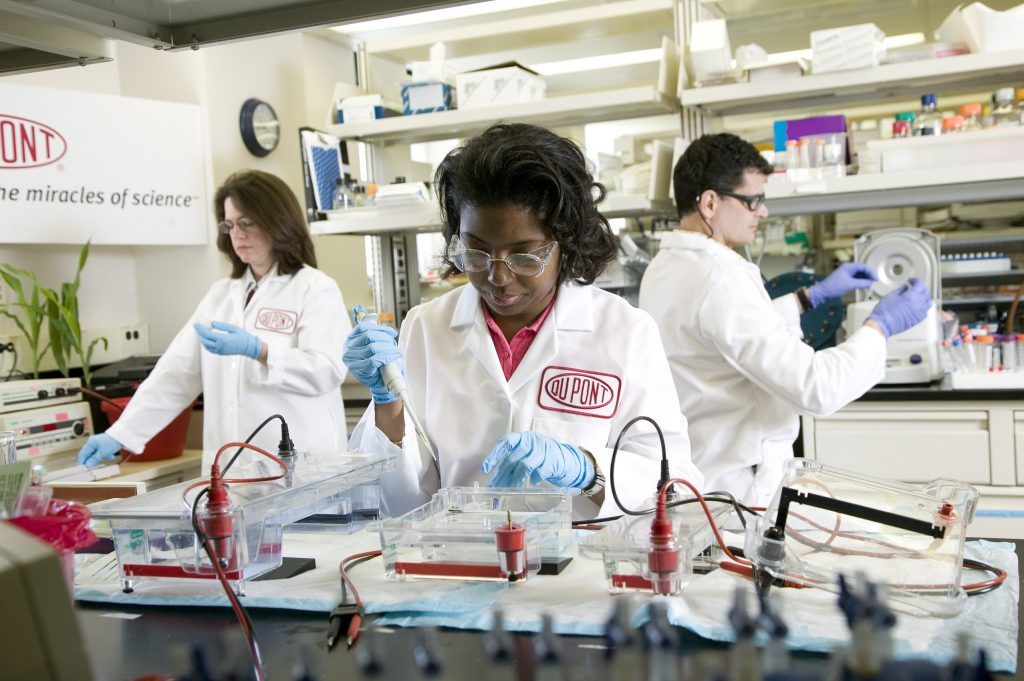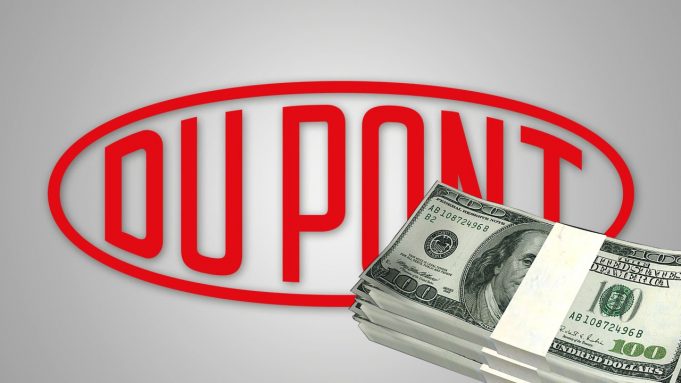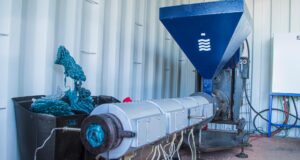This article is about how DuPont makes money. Firstly, we explain the business segments of DuPont and how the company generates revenue from each of those segments. Then, we discuss, key elements of DuPont business model. Finally, we share the revenues, the profits, and the profit margins of DuPont for 2015.
E.I. du Pont de Nemours and Company (“DuPont”) is a leading diversified chemical company. DuPont provides customized solutions across three strategic focus areas: Agriculture & Nutrition, Bio-Based Industrials, and Advanced Materials. The company operates through seven segments that include: Agriculture, Electronics & Communications, Industrial Biosciences, Nutrition & Health, Performance Chemicals, Performance Materials, and Safety & Protection.

- Agriculture segment businesses deliver a broad portfolio of products and services that are specifically targeted to achieve gains in crop yields and productivity, including Pioneer brand seed products and well-established brands of insecticides, fungicides and herbicides.
- Nutrition & Health segment offers sustainable, bio-based ingredients and advanced molecular diagnostic solutions, providing innovative solutions for specialty food ingredients, food nutrition, health and safety. The segment’s products include cultures, emulsifiers, gums, natural sweeteners, and soy-based food ingredients. The products hold leading market positions based on industry leading innovation, relevant product portfolio and close-partnering with the world’s food manufacturers.
- Industrial Biosciences segment develops and manufactures a broad portfolio of bio-based products, enzymes that add value and functionality to a broad range of products and processes such as animal nutrition, detergents, food manufacturing, ethanol production, and industrial applications resulting in cost and process benefits, better product performance, and improved environmental outcomes.
- Electronics & Communications segment supplies differentiated materials and systems for photovoltaics, consumer electronics, displays and advanced printing that enable superior performance and lower total cost of ownership for customers.
- Performance Materials segment provide productive, higher performance polymers, elastomers, films, parts, and systems and solutions which improve the uniqueness, functionality and profitability of its customers’ offerings.
- Safety & Protection segment businesses, protection technologies, sustainable solutions, and building innovations deliver products and services to a large number of markets, including construction, transportation, communications, industrial chemicals, oil and gas, electric utilities, automotive, manufacturing, defense, homeland security, and safety consulting.
- Performance Chemicals segment delivers customized solutions with a wide range of industrial and specialty chemical products for markets including plastics and coatings, textiles, mining, pulp and paper, water treatment, and healthcare.

Key Elements Of DuPont Business Model
DuPont is restructuring its business to become a global biosciences major with following changes in its business model design:
- Consolidate business segments and divest under-performing or non strategic businesses
- Integrated product development efforts for assets, applications, and services
- Transition from product company to a solutions company

DuPont Focus On Business Segment Consolidation
DuPont is working on strategic portfolio transformation program to position itself as a higher growth, higher-value company among its competitors in the global industry. It has taken decisive actions to divest highly cyclical and commoditized businesses from its portfolio. In 2013, DuPont divested its entire performance coatings division to The Carlyle Group and has announced to separate its performance chemicals business. This divestiture helped DuPont consolidate its business segments into specialized and profitable operations. It has also acquired high growth business including Danisco and Pannar that are strategic fit to its targeted segment. The company has identified Agriculture & Nutrition, Advanced Materials and Industrial Biosciences as the three strategic growth pillars.
- Agriculture and nutrition segment. DuPont is focused on extending their reach and differentiate themselves as market leaders in this segment.
- Advanced Materials. The company plans to strengthen its lead as a provider of industrial materials. This segment’s engineered polymers and packaging resin have the ability to accelerate growth in developing markets for DuPont.
- Industrial Biosciences. DuPont intends to combine its advanced materials segment and its agriculture & nutrition segment in order to build a new bio-based business segment. This area of the business will drive new innovation and support the company’s growth plans for the coming years.

DuPont Focus On Integrated Product Development
DuPont has a strong history of developing innovative products. As of December 2014, it had 27,000 global patents, 5 National Medals of Science and Technology and one Nobel Prize for its innovation. DuPont was named top 100 Global Innovator for 4 consecutive years by Thomson Reuters in 2014. DuPont with its focused segmented approach is in a commanding position to combine science and its technology capabilities, global industry knowledge and market access to lead industrial Bio-Based technology revolution. To further its integrated product development agenda it has launched innovation center network to develop tailored solutions by collaborating with local strategic customers.
DuPont Focus On Building A Solutions Company
In alignment with the shifting needs of its customer base, DuPont has integrated a full array of services into its core business model to help its customer deal effectively with the changing business problems. DuPont today across its 12 business segments is not only providing high quality products at a competitive price, but also helping the customers handle, store, and apply the products in the right way.

How DuPont Generates Revenues?
DuPont generates its revenues by directly selling to customers and through channel partners.
- Direct selling. DuPont sells directly to customers through its account teams
- Selling through channel partners.
- Network selling. DuPont reaches out to its customers through its widespread networks that includes independent retailers, dealers, agricultural cooperatives, and farmer networks
- Licensing selling. DuPont also generates revenues by signing Out-Licensing deals with trade and commercial.

DuPont Revenues By Business Segment FY 2014
In FY’14 (fiscal year ending December 31, 2014), DuPont generated $36.0 billion of total revenues. Of these total revenues, DuPont generated:
- $11.3 billion revenues, 31.3% of the total, from the agriculture segment
- $6.3 billion revenues, 17.5% of the total, from the performance chemical segment
- $6.1 billion revenues, 16.8% of the total, from the performance material segment
- $3.9 billion revenues, 10.8% of the total, from the safety & protection segment
- $3.5 billion revenues, 9.8% of the total, from the nutrition & health segment
- $2.4 billion revenues, 6.6% of the total, from the electronic & communication segment
- $1.2 billion revenues, 3.5% of the total, from the industrial biosciences segment
- $1.3 billion revenues, 3.7% of the total, from the others segment
DuPont Profits And Profit Margins FY 2014
Of the $36.0 billion of DuPont total revenues in FY’14, $21.7 billion were the cost of goods sold. This resulted in $14.3 billion of gross profit and a gross margin of 39.8%. DuPont operating costs were $9.4 billion. These include Selling, General, and Administrative (SG&A) expenses, Research & Development (R&D) expenses and other operating charges. This resulted in $4.9 billion of operating profit and an operating margin of 13.8%. After income taxes, DuPont had a net profit of $3.6 billion and a net margin of 10.1%.






